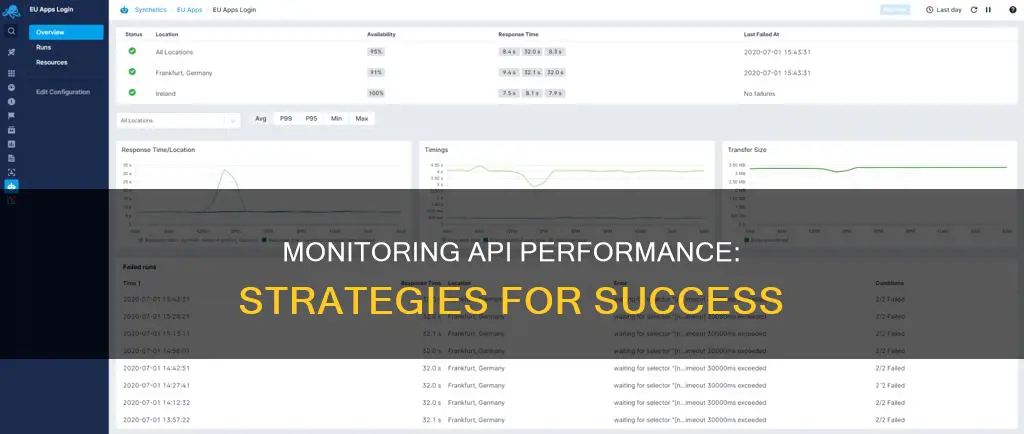
Application Programming Interfaces (APIs) are an incredible tool that allows developers to build web applications and facilitate the exchange of information between various web services. As APIs are now an integral part of our daily lives, it is critical to monitor their performance to ensure they are available and functioning properly.
API monitoring is the process of observing an API's uptime, downtime, and overall performance to ensure optimal functionality. This can be done through the use of API monitoring tools, which help to proactively monitor API performance and identify any issues or failures. By conducting API monitoring, developers can gain valuable insights into the availability, response, and functional correctness of their APIs, ultimately enhancing the user experience and safeguarding brand reputation.
There are various API monitoring tools available, ranging from free and open-source options to paid solutions. These tools offer features such as uptime and response monitoring, performance testing, and data validation, providing detailed insights into API performance.
By implementing API monitoring, developers can ensure the smooth operation of their web applications and maintain a positive user experience.
| Characteristics | Values |
|---|---|
| Purpose | Monitor API availability, downtime, and overall performance |
| Benefit | Ensure API is available and functioning properly, within performance thresholds |
| Data Collected | Uptime, downtime, latency, response codes, errors, proper responses, etc. |
| Tools | JMeter, Taurus, BlazeMeter, New Relic, Uptrends, Amazon CloudWatch, etc. |
What You'll Learn

Monitoring API availability and performance
API monitoring is a synthetic approach to monitoring an API (Application Programming Interface) for availability, proper responses, and performance. API monitoring helps identify outages and poor-performing API calls that cause applications to fail, dependent services and websites to fail, and adversely affect the user experience.
API monitoring is the process of observing the functional, availability, and performance metrics of an API. This can be done by using API monitoring tools to help proactively monitor API performance. Monitoring tools are great for automating the monitoring process versus having to make API checks at random times.
API performance is dependent on many factors and relationships, and because of this, issues can occur at any time. It is the unpredictable nature of APIs that make API monitoring tools essential for organizations. They can quickly alert you and your teams the moment issues arise, so corrective actions and troubleshooting can begin as soon as possible to avoid more users being impacted.
There are two types of API monitors: basic and multi-step monitors. Both monitor types can evaluate and track uptime and performance as frequently as once per minute. Basic API monitors test a single API call, while multi-step API monitors go beyond checking a single response and check complete API interactions.
When monitoring APIs, it is critical to monitor how they perform from a user's perspective. This includes using a solution that can support API monitoring checks every minute, 24/7. Additionally, for the most mission-critical and business-critical APIs, you will need a solution that goes above and beyond just monitoring requests and responses. This means using a solution that can monitor authentication methods, request types, timeout thresholds, content validation, custom headers and custom scripts, and alerting mechanisms.
Blind Spot Monitor: A First Year Essential?
You may want to see also

Using API monitoring tools
API monitoring tools are used to check availability, uptime, and functionality of APIs, and are used by development teams to understand ongoing performance. They allow teams to be alerted when errors and performance thresholds occur, so they can quickly troubleshoot and fix the issues before any more users are impacted.
There are two types of API monitoring tools: free and paid. Free API monitoring tools are free to the user and do not require any upfront costs or investments. However, they typically do not have a robust feature set and may not be as secure as paid tools. Paid API monitoring tools often include additional features, multi-protocol support, access to ongoing updates, and global monitoring locations.
- Dotcom-Monitor: A synthetic monitoring solution for web pages, web applications, infrastructure, and web services. It offers monitoring for RESTful and SOAP-based APIs, SSL certificate checks, and WebSocket-based applications.
- Uptrends: Offers synthetic monitoring products for websites, web applications, servers, and APIs, with features like authentication, content validation, and request duration monitoring.
- Site24x7: An all-in-one monitoring suite for development teams, supporting SOAP and RESTful-based API services and various authentication methods.
- Amazon CloudWatch: A monitoring and observability service built into Amazon Web Services (AWS), allowing users to monitor apps performance, uptime, network bandwidth, resource usage, and more.
- AlertSite: A synthetic, real browser-based monitoring product for APIs, websites, and applications, offering over 350 external monitoring locations and support for technologies like SAML/SSO and OAuth for APIs.
- JMeter: An open-source tool used for performance testing, which can be used on any platform that supports Java.
- Taurus: An open-source API testing tool that automates and runs performance tests, enabling simplified running of other tests from tools like Gatling, Locust, and Selenium.
- BlazeMeter: A performance testing tool that can be used to scale JMeter and Taurus scripts to thousands of users and run tests from different locations.
Choosing the Right Studio Monitors: A Buyer's Guide
You may want to see also

Basic API monitoring
API monitoring is the process of observing the functional, availability, and performance metrics of an API. APIs are used to retrieve, send, and exchange information from various web services. They are used every day, from booking a hotel room to checking the weather.
API monitoring helps determine API availability, their behaviour, and whether they are functioning as expected. It is a way of gaining visibility and evaluating the availability, performance, response, and functional correctness of an API. This practice helps identify any outages or underperforming APIs that can lead to application, website, or service failure.
API monitoring helps you:
- Determine API availability
- Understand their behaviour
- Ensure they are functioning as expected
Key Metrics to Monitor
- Uptime: The continuous availability of an API, ensuring it is fully functional without any outages.
- Requests Per Minute: A performance metric that measures the number of requests the API handles per minute.
- CPU Usage: Monitoring CPU usage is important as high usage can indicate an overloaded server, causing a bottleneck.
- Latency: The time it takes for data or a request to go from one system to another.
- Memory Usage: Helps understand resource utilisation; high memory usage can indicate overloaded servers.
- Time to First Hello World (TTFHW): The time a user needs to make their first API transaction.
- Errors Per Minute: The number of API calls with failure responses.
Benefits of API Monitoring
- Cost-Effective: API monitoring can help provide a cost-effective method to ensure that the APIs your organisation uses are continually up and running.
- Issue Resolution: Monitoring allows you to get alerted when an API begins experiencing issues, so you can start working on a solution immediately.
- Maintain User Experience: Monitoring helps ensure a seamless user experience. Slow load times and delays can frustrate users, who may then turn to competitors.
Drawbacks of Not Monitoring APIs
- Revenue Loss: Downtime can cost organisations thousands of dollars per minute.
- Loss of Customer Trust: Regular API failures or issues can lead to frustrated users and a loss of trust.
API Monitoring Tools
There are a variety of API monitoring tools available, from free and open-source to paid options. These tools help automate the monitoring process, providing alerts when issues arise. Some popular paid API monitoring tools include:
- Dotcom-Monitor
- Uptrends
- Site24x7
- Amazon CloudWatch
- AlertSite
Cloud Usage Monitor: Understanding Cloud Consumption
You may want to see also

Multi-step API monitoring
To set up multi-step API monitoring, you will often need to use multiple HTTP requests. This involves setting up a sequence of requests, where each new request uses data from a previous request to perform its task.
- Click the "+" button in the menu "Monitoring > Monitor setup".
- Go to "Monitoring > Monitor setup" and click the "+" button again.
- In the pop-up dialog, select "Multi-step API" as the monitor type and click "Choose".
- Name your monitor and set the check interval, which is the time between the end of one check and the start of the next.
- Switch to the "Steps" tab to input the details for each step.
- Add additional steps as needed and edit their details. You can also remove, duplicate, or change the order of the steps.
- Configure each request step by selecting the appropriate HTTP method, filling in the URL, and adding a short description.
- Specify the data you want to send as part of the request, such as JSON data, XML data, or encoded form data.
- Add any necessary request headers, such as the Content-Type header, to specify the format of the data being sent.
- If your API requires authentication, include the appropriate header and data in the Value field.
- Define assertions (checks) for each response to verify the HTTP status code, content checks, request duration, and more.
- Extract content from the response body, headers, or cookies and store them as variables to be used in later steps.
By following these steps, you can ensure that your API is behaving correctly and performing within the specified limits. Multi-step API monitoring provides a step-by-step approach that makes it easy to set up powerful scenarios without adding complexity.
Connecting a Second Monitor to Your iMac: A Step-by-Step Guide
You may want to see also

Monitoring API correctness and data validation
- Data Validation: This involves ensuring that the data returned by the API conforms to predefined rules and structures. It includes checks for data format, type, and business logic to guarantee data accuracy. For example, performing rigorous checks on data types such as integers, strings, and dates to prevent issues arising from incompatible data types.
- Data Verification: This focuses on confirming the accuracy and correctness of the data. It includes activities such as data cleansing, reconciliation, and profiling. Data cleansing involves identifying and correcting inaccurate or incomplete data using techniques like outlier detection and normalization. Data reconciliation involves comparing data across different sources to identify inconsistencies, while data profiling involves analyzing data characteristics and identifying anomalies using profiling tools.
- Schema Enforcement: Schemas such as JSON Schema and OpenAPI are used to define the structure and format of data exchanged through APIs. By adhering to a clear schema, APIs can minimize unexpected errors and ensure data integrity.
- Business Logic Validation: Implementing custom validation rules specific to the business requirements ensures that the data aligns with the unique needs of the application.
- Performance Monitoring: Monitoring the response time of API endpoints helps identify potential delays or performance issues. It involves measuring metrics such as TCP, DNS, and first byte times to assess the speed and availability of the API.
- Availability Monitoring: Checking the availability of the API from different locations, especially in a global context, helps identify region-specific issues and ensures consistent user experiences worldwide.
- Error Handling and Logging: Implementing comprehensive error handling mechanisms and logging data errors facilitates the quick identification and resolution of issues. Detailed logs provide valuable insights into the root causes of data discrepancies.
- Monitoring and Alerting: Continuous monitoring of data quality and setting up alerts for potential issues allows for proactive identification and swift resolution of problems, minimizing the impact on operations.
- Data Integrity and Consistency: Maintaining data integrity and consistency is crucial to prevent operational errors, misinformed decisions, and security breaches. It ensures that data remains accurate, reliable, and consistent across interconnected systems, preventing disruptions and misinterpretations.
Troubleshooting LCD Monitor: Blinking Issue Explained
You may want to see also
Frequently asked questions
API monitoring helps to ensure that your API is available and functioning properly, as well as within performance thresholds. It helps to identify any outages or underperforming APIs that can lead to application, website, or dependent service failure. It also helps to identify, prevent, and solve issues before they become a bigger problem.
Some API monitoring tools include:
- RapidAPI for Teams
- Dotcom-Monitor
- Uptrends
- Amazon CloudWatch
- Assertible
- API Fortress
- Stackify
- Smartbear
- JMeter
- Taurus
- BlazeMeter
- New Relic
- Ruxit
- DynaTrace
- Runscope
- Datadog
- AppDynamics
- Graphite
- Kibana
- InfluxDB
- Splunk
Here are some tips for API monitoring best practices:
- Make a record of all the APIs your organisation has developed, as well as any third-party APIs.
- Prioritise the APIs from most critical to least critical.
- Consider the complexity and technologies the APIs rely on, such as authentication methods and security.
- Set up monitoring from multiple locations to compare performance.
- Set up alerts to notify the appropriate stakeholders when errors or issues arise.







